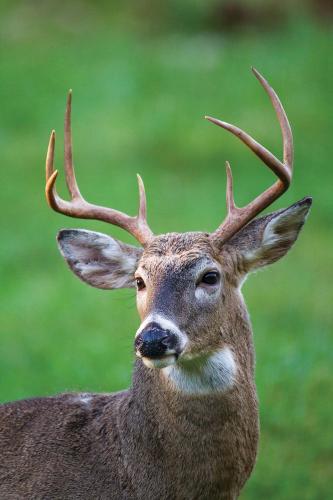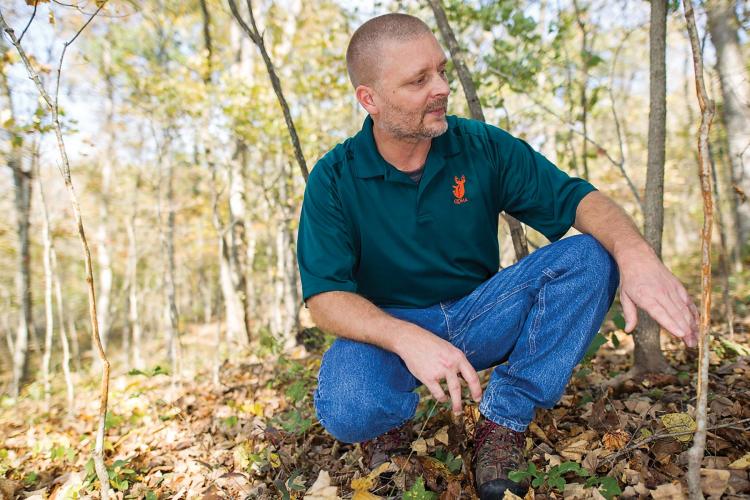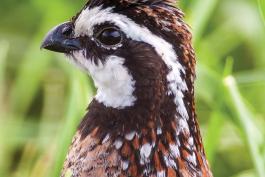A bobwhite quail whistling on a June morning cares not if his call passes to a neighbor’s farm, only that another bobwhite hears and answers, “bob, bobwhite.” Deer and turkeys pay little heed to property lines, too, as they hop over fences seeking food, shelter, and to mingle with others of their species. Their boundaries are defined where timber, shrubs, or grasses begin and end.
That’s why MDC helped Kevin Strange and his farm neighbors, including Joe Pipta form the Bee Ridge Quail Focus Area in Knox County. A single farmer planting quail-friendly cover helps wildlife. But when neighboring farm owners share expertise, equipment, and helping hands to implement wildlife-friendly practices alongside crops and pastures over broad areas, their return is more wildlife for all.
“Having more people doing things to enhance everything is what benefits us a lot,” Pipta said. “Our farms are connected, it’s a contiguous area. We can’t control where the birds go. But we can control having a place for them to go. Give them a place to go with food and cover, and they’ll be there.”
Farmers and property owners across Missouri have formed dozens of formal or informal cooperatives to boost wildlife. Some participants seek better hunting. Others don’t hunt but plant native grasses and help neighbors with prescribed burns to improve habitat because they enjoy watching wildlife. Some co-ops hold annual fish-fry community gatherings and sponsor youth hunts. For others, participation may simply be sharing ideas over café coffee or disking a field edge for a neighbor. Their efforts are important because 93 percent of the state’s acreage is privately owned, and Missourians value nature.
Making Management Work for Wildlife
Much of the 12,000 acres within the Bee Ridge co-op’s rolling hills is planted in corn and soybeans, or it’s used as pasture or hay fields. But since forming the co-op a decade ago, 18 landowners have also provided 1,300 acres of quality habitat for wildlife to find food, raise young, and endure freezing winters or blistering summers. About 250 acres are in cover strips that border crop fields. The largest tracts are fields converted from crops into grasses and forbs through the U.S. Department of Agriculture's Conservation Reserve Program (USDA/CRP).
“This is a way of giving back a little bit to wildlife,” said Pipta, who enjoys hunting on his farm.
For their efforts, Bee Ridge farmers are seeing more quail and other wildlife. In 2008, they began annual fall quail covey counts. They set up listening posts to locate calling coveys inside and outside the co-op boundaries.
During the first years, they averaged one to two coveys more per listening post inside the focus area compared to sites outside. Then a 20-inch snowfall in February 2011 caused quail numbers to plummet for a few years. Quail numbers inside the focus area with habitat improvements rebounded gradually, back up in 2016 to earlier highs with an average of 3.3 coveys per listening post. But outside the focus area, quail have not rebounded to earlier levels. In 2016, the count lingered low at one covey per listening post. “We’re seeing several more coveys,” Pipta said of the focus area. “We’re also seeing a lot more songbirds and rabbits.”
MDC staffers advise co-ops on habitat managementstrategies. They also help landowners use cost-share or grant funds from various state, federal, or private conservation programs that make habitat improvements affordable.
Strange and neighbors use payments from federal conservation programs such as CRP to offset practice costs. A practice through CRP called Habitat Buffers for Upland Birds, also known as CP33, helps pay for planting native grasses and wildflowers in cover strips 30 to 120 feet wide in eligible fields. Those strips also help with soil and water conservation. Often, cover strips are planted in marginally productive areas for crops due to soil conditions, drainage, or shade from a bordering fence row. Landowners also use a program where MDC matches funds allocated to them by private conservation organizations. Bee Ridge farmers used the local Quail Forever chapter's Habitat Challenge Grant. Grants are available for edge feathering, which is dropping trees to the ground to provide quail escape and loafing cover. Various cost-sharing programs help pay for timber stand improvement, such as thinning trees to encourage woodland grasses and wildflowers.
“Reimbursements vary, but those programs can reimburse farmers for significant amounts of habitat improvement costs,” said John Pinkowski, an MDC private land conservationist who helped organize the Bee Ridge co-op.
Herb Wedemeier is using cost-share from a federal conservation program to convert a 7-acre corner field into native wildflowers that are important for pollinator insects such as bees and butterflies. The wildflowers are also useful to deer and birds. He took an extra step of placing downed trees at intervals in the middle of the field and along fencerows as places where quail can dodge predators.
“We figured we would do some things that made sense economically but also takes care of the critters,” Wedemeier said.
A Neighborly Strategy for Trophy Deer
Ted Slinkard is confident hunters this fall will see mature bucks with large antlers roaming the timbered Ozark hills in his Bollinger County neighborhood of southeast Missouri. Slinkard, of rural Patton, knows habitat improvements by landowners in the Mayfield Holler Wildlife Cooperative help the deer. Co-op members agreed that it’s good management to pass on shooting young bucks so they can grow into large bucks. They also track deer trends on their land with photos taken by trail cameras in a two-week survey during August.
“We’ve been doing a trail camera survey since 2012,” Slinkard said. “Last year, we had 40 cameras out with 4,000 acres under survey.”
The co-op held their first meeting in 2012 after a severe drought caused a drop in the local deer population. They’ve worked since then with MDC staff and experts from private conservation groups to boost their neighborhood’s deer herd. Landowners who participate annually in the survey also do timber stand improvement projects to benefit trees like oaks that provide acorns, a key wildlife food. They thin timber, establish fire lines, and help each other with prescribed burns. Those steps boost grasses and wildflowers among the trees, creating more food for deer and all wildlife.
“White-tailed deer, while they seem to be our biggest focus, we’re trying to do this for all wildlife,” Slinkard said. “We’ve got a few quail hunters. Basically, it’s just habitat management and trying to get everybody to work together. Last year, we did edge feathering and timber stand improvement demonstrations for people. It’s for all wildlife, but mainly for deer hunting.”
The deer are responding. Doe and fawn ratios are improving, helping the co-op’s goal of boosting the local deer herd population. During hunting season, Slinkard values seeing bucks 3 years old or older. Their antlers are bigger and they provide more venison.
“Before, we might have had one or two shooter bucks a year,” he said. “Now we have four or five a year.”
Part of that success is due to communication between co-op members who hunt deer, share property lines, and share a deer herd that moves across those lines.
“When neighbors know I’ll let the young deer go, they will let it go,” Slinkard said. “We’re starting to let the young bucks walk.”
Landowners Are in Control
Co-op participation is voluntary. Landowners choose their own land management strategies, and they control access to their property.
“One of the huge keys to success for co-ops is that local landowners need to lead it,” said Bill White, MDC Private Land Services division chief.
Wildlife co-ops exemplify partnerships. MDC staff members provide expertise at co-op meetings and field days. Groups like the Quality Deer Management Association (QDMA) are also active in promoting wildlife-friendly habitat and organizing landowner co-ops throughout Missouri.
“Wildlife populations are more viable when there’s an interchange of genetics across a broad landscape,” said Brian Towe, QDMA wildlife management specialist. Plus if weather, disease, or predator events knock a wildlife species down on one farm, healthy populations on adjoining farms can help numbers rebound.
“For wildlife populations to grow or overlap, we need connecting habitats,” Towe said. “The goal with co-ops is to ensure if a quail, deer, or turkey moves to another piece of property, there’s going to be food, shelter, and cover for them.”
Boosting deer numbers was a primary goal when the 25 co-ops he works with organized. But many landowners are also interested in helping all wildlife. For example, the habitat work within Newton County’s Bullskin Creek co-op can also help turkeys and grassland birds in Missouri’s southwest corner. Grasses and forbs boosted by timber stand improvements and prescribed burns serve as deer browse. But native plants also provide nesting cover and host insects that birds feed on, especially helpful for quail raising broods in early summer.
“We’ve seen several co-ops where, when they started, they hadn’t seen quail for a while, and now they’re seeing quail,” Towe said. “They get excited because they’re seeing more quail, more turkeys, and more deer.”
A desire for better deer hunting prompted landowners to create the Big Buffalo Creek Landowner Cooperative in west-central Missouri near Cole Camp. Achieving that goal is based on using timber management, native grass and forb restorations, and prescribed burns to create diverse food and shelter sources that help all wildlife, said Dave Niebruegge, MDC private land conservationist. “I encourage them to restore a fully functional woodland ecosystem.”
If a landowner is working to improve habitat on a farm but not getting desired results, such as more quail, the next step may be organizing a co-op among neighbors. Quail and turkeys may need room on more than one farm to rebound. But cooperation need not be complicated. Property owners in the Carroll County Quail Focus Area in northwest Missouri simply share ideas and help each other annually with prescribed burns, said Lee Metcalf, an MDC private land conservationist who assists the co-op. Quail numbers have risen on co-op farms.
“Most of the co-ops I work with are fairly informal,” said Alex Foster, a QDMA wildlife management specialist serving northern and west central Missouri. “It’s just neighbors getting together.”
Those gatherings lead to actions on the land that boost wildlife but also promote natural beauty, better water quality, and healthy soils. Some co-op members take extra steps to help wildlife.
In the Bee Ridge Quail Focus Area, each autumn Kevin Strange leaves a few rows of corn or soybeans as winter food for wildlife. He does little fall tillage, preferring to leave corn stubble as winter cover for critters. Green cover crops such as rye are planted in some fields during winter for soil health, livestock forage, and wildlife. He uses native grasses while resting crop fields in the federal USDA/CRP program. Quail and deer benefit, and so do neighbors who value wildlife.
Last winter, a season often challenging for wildlife, he stepped out of his country church early one evening and heard two quail coveys calling to one another from Bee Ridge fields. He knew good habitat would carry them through to this summer’s nesting season. “I think there’s room for the farming and the wildlife,” Strange said.
80 Years of Conservation
Ninety-three percent of Missouri land is privately owned. To support landowners’ efforts to manage for fish, forests, and wildlife, the department established the Private Land Services division in 2000. MDC remains the only U.S. state fish and wildlife agency with a full division dedicated to helping landowners. Start a Wildlife Cooperative Landowner wildlife cooperatives offer the advantage of pooling expertise and resources to help property owners achieve their wildlife management goals. MDC assists property owners with wildlife habitat improvements. Staff can recommend strategies and connect landowners with loaner equipment or financial resources to make improvements. For assistance, contact your local MDC office or visit mdc.mo.gov/property.
For help from the Quality Deer Management Association in forming a landowner wildlife cooperative, call Brian Towe at 573-397-1664 or Alex Foster at 660-605-0501. Ted Slinkard is a landowner and organizer of the Mayfield Holler Wildlife Cooperative in Bollinger County.
Free Publication Helps You Help Habitat
The deeply revised, full-color 2017 edition of Wildlife Management for Missouri Landowners provides new and updated information on the latest in wildlife habitat management techniques. To order your free copy, email the publication title and your mailing address to pubstaff@mdc.mo.gov, or call 573-751-4115, ext. 3630.










And More...
This Issue's Staff
Art Director - Cliff White
Associate Editor - Bonnie Chasteen
Staff Writer - Heather Feeler
Staff Writer - Kristie Hilgedick
Staff Writer - Joe Jerek
Photographer - Noppadol Paothong
Photographer - David Stonner
Designer - Les Fortenberry
Designer - Marci Porter
Designer - Stephanie Thurber
Circulation - Laura Scheuler






















